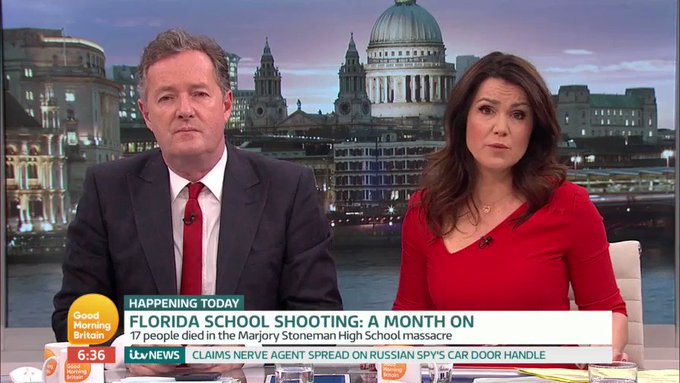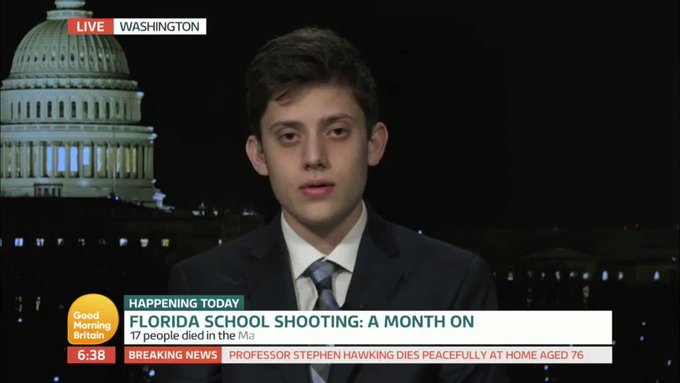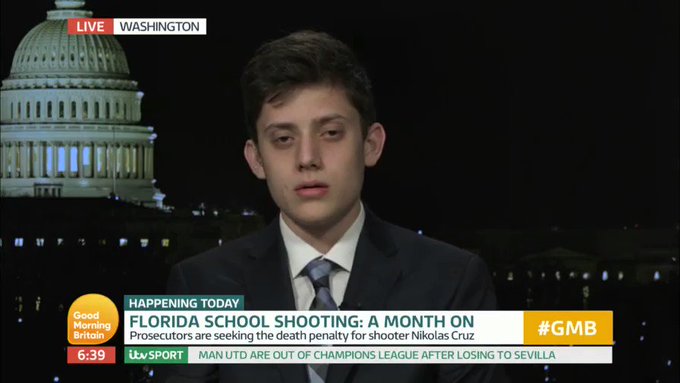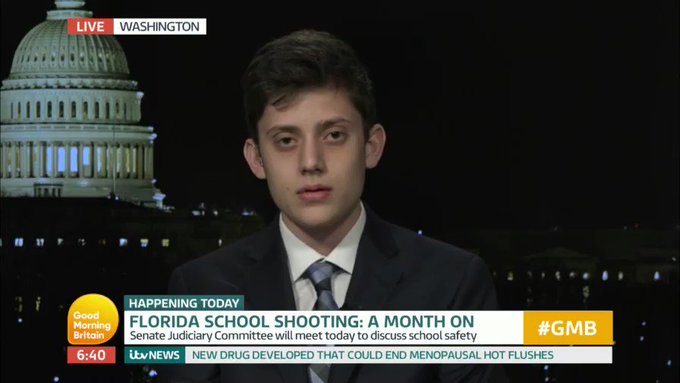WATCH: Parkland Survivor Kyle Kashuv Debates Piers Morgan On Gun Control

On Wednesday, Parkland survivor Kyle Kashuv appeared on “Good Morning Britain” to discuss guns, gun control, and the STOP School Violence Act of 2018.
There were four major exchanges throughout Kashuv’s segment with hosts Piers Morgan and Susanna Reid that stood out.
First, they spoke about arming teachers:
REID: You actually support, don’t you, President Trump’s suggestion that teachers should be armed. Do you think that might have stopped what happened a month ago?KASHUV: The thing with teachers is this — we don’t have the funding even for, like, teachers themselves ... and we need to find a way to protect our schools. Not every school can get three armed officers, and we need to find a middle ground because we don’t have the funding for three armed officers outside every school — and patrolling each school. And the only logical solution is having teachers. What we want to do, what the Marshal Plan proposes is that it gives schools the opportunity — the superintendent, and the county, and the teacher all have to voluntarily say “yes” to this. No one is forcing anyone to do so. A kindergarten teacher who can’t handle recess with her kids won’t be the one having a gun; it will be ex-military, someone who’s been around guns their entire life.
Next, Morgan challenged Kashuv over raising the age limit on firearm purchases:
MORGAN: Donald Trump, in the wake of the shooting, he came out with a lot of what I thought were very promising statements about wanting to increase the age limit, for example, for buying guns in Florida and around America from 18 to 21; banning bump stocks, which were used to convert semi-automatic guns into virtual automatic guns, and so on. But he's reined back on all this, and this week, really the only thing that he put forward was extended background checks — which is fine — but it doesn't, in my view, go nearly far enough. Do you not feel it's weird that in Florida for example you can't buy a beer until you are 21, but you can buy an AR-15 gun?KASHUV: I don't think that's the argument. That's not the argument at all. Why shouldn't a mother — a single mother of two be able to defend her children in her own home — who's 20? Why can't a 20-year-old single mother be able to defend her children? Raising the age from 18 to 21 won't solve the problem. It simply like a reactionary statement to what happened in Parkland.
Next, Morgan and Kashuv discussed gun deaths in the U.K. versus the United States, and Kashuv had to redirect Morgan, who went off topic:
MORGAN: Do you understand though, in a country like Britain, where we don't really have any guns, we look at this and we say, "Why wouldn't you want to do at least something?"KASHUV: That's not true. When you talk about guns, although the mass murders went down, murders went up.MORGAN: That's simply not true, Kyle, and this is a problem. The gun lobby in America would love people to believe that. Here's the reality — every year in Britain, 32 people die from gun-related deaths. Every day in America, that number is 85. America has more gun deaths per year. ... America has more gun deaths than the next 22 richest countries in the world combined. And at some point, surely, there has to be some form of tighter regulation to just try and stop these incessant shootings.KASHUV: Let me tell you something, most of the deaths that you see are from suicides. The next majority, all right, is gang-related violence. And stripping away the rights of individuals who are law abiding citizens won't solve the problem. And let's say we look at assault rifles. 3% of all gun deaths are with assault rifles; 68% of those are suicides. So saying that we're going to ban all semi-automatic rifles will not solve the problem. We have to look a gang-related violence [because] that's where most of the numbers come from.
Kashuv is correct. According to government data from the U.K.’s Office of National Statistics, following the Firearms Act in 1997, homicides increased.
Looking at FBI statistics, from 2010 - 2014, there were 63,061 gun homicides. Of those, 1,530 were committed using a “rifle.” That’s an average of 2.4%. Handguns, however, were used in 47.7% of gun homicides during the same period.
According to FiveThirtyEight, “two-thirds of the more than 33,000 gun deaths that take place in the U.S. every year are suicides.”
Lastly, when Morgan brought up Sandy Hook, Kashuv noted that Parkland isn’t comparable, as the abject failure of the authorities was a major factor:
MORGAN: So, in 2012 [at] Sandy Hook, a deranged young man took an AR-15, and shot up a school, and killed 20 children. Absolutely nothing was done to stop further deranged young men doing the exactly the same thing, and indeed, in Florida, in your school, just a month ago, another one did exactly the same thing with the same firearm.KASHUV: ... it's very different what happened at our school. What happened at our school is that there were 78 reports to Broward Sheriff's Office, and nothing was done. Two tips to the FBI. Had this been reported to the proper bureau, he wouldn't have been able to buy a gun with his past prior record. [There's] not a proper recording of evidence.MORGAN: But Kyle, that doesn't change the fact that he still took a semi-automatic rifle that he bought legally along with six other guns —KASHUV: What do you suggest?MORGAN: Here's what I suggest. I suggest that America suddenly gets very serious about guns, right? It's more difficult to actually get a car legally with all the regulations than it is to buy a semi-automatic rifle in many states. It's more difficult to buy a pet dog in some states in America than it is to buy a semi-automatic rifle.KASHUV: I'll tell you why, because owning a gun is a right, not a privilege, as shown by the Second Amendment.MORGAN: I understand that, but my 20-year-old son was rejected from buying a non-alcoholic beer in California because it had 0.001% alcohol, and yet in Arizona, a week later, an 8-year-old girl was allowed to fire an Uzi machine gun at a gun range, and she killed her instructor by mistake. That is legal. Now again, I'll say to you —KASHUV: That's a false — what you're saying here isn't really fair to the argument. Simple mistakes that happen because they're not [properly] supervised doesn't represent America and the gun culture in America.MORGAN: So you think it's okay for 8-year-old kids to fire Uzi machine guns with real bullets?KASHUV: I don't think that specific case is even relevant to the [discussion point] we're talking about right now. We're talking about making sure school shootings [won't] ever happen again.
It’s fair to say that Kyle Kashuv held his own against Morgan in the debate about guns.





